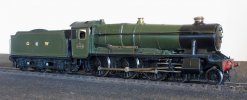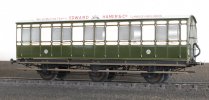Well it’s been a while since I last posted. Two of the coaches on the bench from my last post are these -
A GWR Dreadnought Brake Third in 7mm
View attachment 228584
And a GWR non-corridor compo built by Phil Gomm, also in 7mm. This is early BR as, although in Choc & Cream, it has BR lettering.
View attachment 228585
The other coaches on the bench were bodies only.
The 4mm T6 (ancient Jidenco kit) was a challenge. A poor kit but also not built well, so I had to do a fair bit of remedial work before I could start. In this type of livery a lot of the lining is parallel to an edge so I use the compasses as odd-legs to get the lining in the right place; not this model though as few edges were smooth and true so much adjustment of the lining with a fine brush and white spirit. Anyway, here it is -
View attachment 228617
On to my next project, which is for me. A DA Royal Scot for which Pete Silvester has already done an excellent job on the chassis, as a barter.
View attachment 228618
It’s gone together nicely but with a lot of work to get the fire box to sit properly against the cab front and over the splashers. More anon.
Ian R



























